
The Derwent is a river in Yorkshire in the north of England. It flows from Fylingdales Moor in the North York Moors National Park, east then southwards as far as its confluence with the River Hertford then westwards through the Vale of Pickering, south through Kirkham Gorge and the Vale of York, joining the River Ouse at Barmby on the Marsh. The confluence is unusual in that the Derwent converges on the Ouse at a shallow angle in an upstream direction.

Malton railway station is a Grade II listed station which serves the towns of Malton and Norton-on-Derwent in North Yorkshire, England. Situated on the York-Scarborough Line, it is operated by TransPennine Express, who provide all passenger train services. Once an interchange between four lines, Malton station is now only served by trains operating between York and Scarborough. The station itself is south of the River Derwent, and is actually in the town of Norton which used to be in the East Riding of Yorkshire, bordering Malton which was in North Riding. Both towns have been in North Yorkshire since 1974.
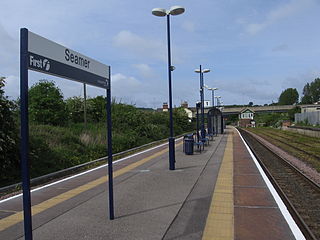
Seamer railway station serves the village of Seamer in North Yorkshire, England. It lies near the end of the Scarborough branch on the TransPennine Express North TransPennine route, 39 miles (63 km) east of York at its junction with the northern end of the Yorkshire Coast Line. Seamer station is managed by TransPennine Express, with services being run by both Northern Trains and TransPennine Express.

Scarborough, formerly Scarborough Central, is a Grade II listed railway station serving the seaside town of Scarborough, North Yorkshire. It lies 42 miles (68 km) east of York and is one of the eastern termini on the North TransPennine route; it is managed by TransPennine Express. and is also served by Northern Trains. The station is also at the northern end of the Yorkshire Coast line and is reputed to have the longest station seat in the world at 456-foot (139 m).

Barton-le-Willows is a village and civil parish in North Yorkshire, England, situated near the River Derwent, about eight miles south-west of Malton. The parish had a population of 186 according to the 2001 census increasing to 284 at the 2011 Census. The village is recorded as Bartun in the Domesday Book.
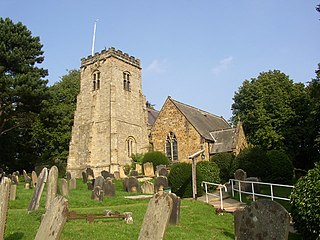
Scalby, a village on the north edge of Scarborough, North Yorkshire, England, is part of the civil parish of Newby and Scalby. From 1902 to 1974, Scalby was an urban district in the North Riding of Yorkshire.
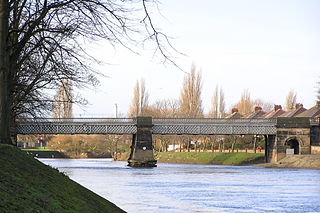
The York–Scarborough line runs between the city of York and the town of Scarborough in England. Towns and villages served along the way are Malton, Norton-on-Derwent and Seamer.
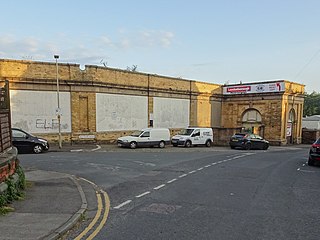
Scarborough Londesborough Road railway station, originally called Washbeck Excursion Station, was built as an excursion station to ease operating pressure at Scarborough Central in the holiday resort of Scarborough. It had a through and a bay platform. Excursion trains from all over the country could be routed into it rather than the main Central station to disembark their passengers before heading onwards to the Whitby branch line to be stabled in carriage sidings at Northstead/Gallows Close on the town's northern outskirts. Return services would follow the same route in the opposite direction to load up before departure.

Heslerton railway station was a minor railway station serving the villages of East Heslerton and West Heslerton in North Yorkshire, England. Located on the York to Scarborough Line it was opened on 5 July 1845 by the York and North Midland Railway. It closed on 22 September 1930.

Crambe is a village and civil parish in the Ryedale district of North Yorkshire, England. It is near the River Derwent and 6 miles (10 km) south-west of Malton. The population as of the 2011 census was less than 100. Details are included in the civil parish of Whitwell-on-the-Hill. The village is located in the Howardian Hills Area of Outstanding Natural Beauty. The father of the renowned mathematician Karl Pearson was born in the village.
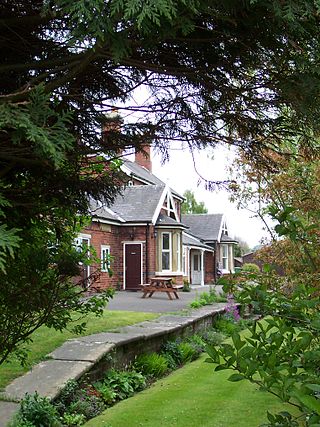
Sawdon railway station was situated on the North Eastern Railway's Pickering to Seamer branch line in North Yorkshire, England. It served the village of Brompton-by-Sawdon and to a lesser extent Sawdon itself. The station was named Sawdon to distinguish it from an existing station called Brompton, near Northallerton, also in North Yorkshire. The station opened to passenger traffic on 1 May 1882, and the last trains ran on 3 June 1950. Sawdon was furnished with one platform, which had the station building on the northern side of the running line, and a small goods yard beyond the station building with an east facing connection to the main railway line. The goods yard had a crane capable of lifting 1-tonne (1.1-ton), and was equipped to handle a variety of goods including live stock.
The Forge Valley Line was a 16-mile-long branch of the North Eastern Railway between Seamer and Pickering in North Yorkshire, England. The line was intended to link Scarborough with Pickering. It opened in 1882 and closed in 1950, with the exception of a stretch from Pickering to Thornton Dale which remained open for quarry traffic until 1963.

Ravenscar was a railway station on the Scarborough & Whitby Railway and served the village of Ravenscar, North Yorkshire, England.

Whitby West Cliff railway station was a railway station on the Whitby Redcar and Middlesbrough Union Railway. It was opened on 3 December 1883, to serve the West Cliff area of the town of Whitby, North Yorkshire, England. It was one of two stations serving Whitby; the other was Whitby Town railway station, which served the lines to Malton and Battersby.
George Townsend Andrews was an English architect born in Exeter. He is noted for his buildings designed for George Hudson's railways, especially the York and North Midland Railway. Andrews' architect's practice in York did not confine itself to railway work, its other buildings including headquarters for two York-based banks and a number of churches.

The North Holderness Light Railway was a proposed light railway, which was to have been constructed between Beverley and North Frodingham, in the East Riding of Yorkshire, England. The scheme was given parliamentary approval in July 1897 for a line extending to 9.5 miles (15.3 km). It was abandoned in 1903 by the North Eastern Railway (NER) and replaced with a bus service though consideration had been given to build the line to a narrower gauge than standard gauge on account of some of the marshy land that the line would have to cross.

Westow is a village and civil parish in North Yorkshire, England. Westow is situated in the lee of Spy Hill, bordering the Howardian Hills Area of Outstanding Natural Beauty, 3 miles (4.8 km) from the A64 road linking Leeds to the East Coast, 5 miles (8 km) west of the town of Malton, and 15 miles (24 km) east of the city of York.
Howsham is a village and civil parish in North Yorkshire, England.

The Thirsk and Malton line was a railway line that ran from a triangular junction on what is now the East Coast Main Line and served eight villages between Thirsk and Malton in North Yorkshire, England. The line was built after a protracted process due to inefficiencies and financial problems suffered by the then York and North Midland Railway.
Gallows Close goods yard was a freight transfer yard on the Scarborough and Whitby Railway in the town of Scarborough, North Yorkshire, England. The yard was opened in 1899 to relieve pressure on the main station in Scarborough and to release space for passenger use. After the Scarborough and Whitby Railway closed down, Gallows Close remained in use as a goods yard until final closure came in 1985.
















